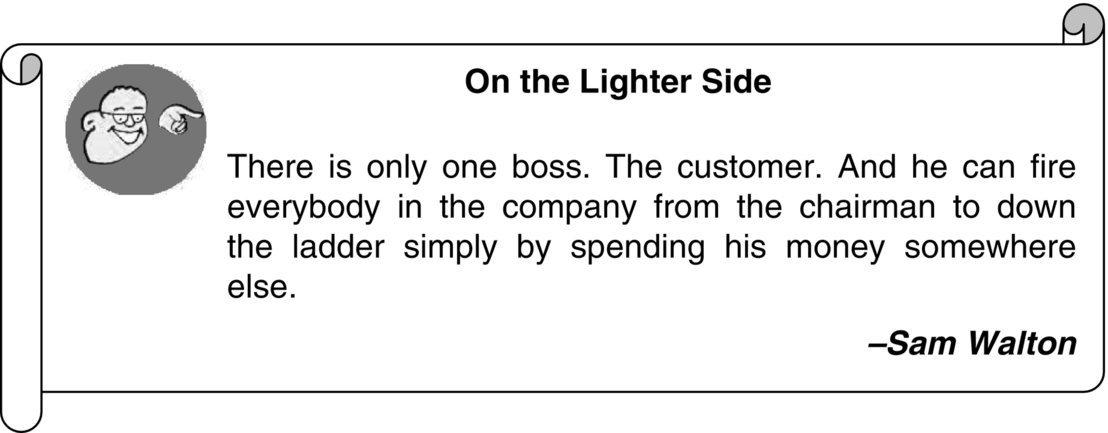Customer Satisfaction
Abstract
Today it is the buyers’ market. Despite the high technology manufacturing process adapted and a high level of quality control exercised, the success of a manufacturing organization depends on how the customer is satisfied with the products or services. This chapter details the several aspects of customer satisfaction and how and why organizations shall strive for not only providing the satisfaction but also to retain him to use his products and services in the long run.
Keywords
Sellers’ market; Buyers’ market; Customer is king; Customer satisfaction; Customer delight; Customer retention; Customer loyalty; Customer attrition; Customer perception of quality; Warranty; Customer types; Kano model; Dissatisfiers; Exciters; Unexpressed needs; Internal customers; ACSI; Front line people; Tangibles; Employee morale; Customer code of ethics
10.1 Sellers’ Market Versus Buyers’ Market
Four decades ago, when you wanted to buy a car, you had to pay the amount in full and wait for long periods, even up to 3 or 4 years to get delivery. If you wanted the color of your choice, or any special feature, you had to wait longer, until the manufacturer programmed that color or feature in lots of 5000 or more. You had to be content with what you got. You would have little choice. Even if the performance was not good, you could not complain. When took it in for repairs, the service personnel would treat you casually, and you had to just leave the car for weeks and months, because the service personnel would say they had too many customers to attend to. This was because the demand was more than the supply, and competition was minimal. It was the sellers’ market and the seller could dictate the terms.
But today, the situation is not the same. With globalization, the supply and thereby, the competition among producers have increased. The customer is not satisfied with just what he gets. If his requirements are not met, he has other makes or models from which to choose. So the company must improve its quality of production, as well as service to satisfy the customer and to stay in the industry. Today, the customer can dictate his terms and get what he wants. This is called a buyers’ market.
10.2 Customer is King
The customer is the most important person in our business.
He does not depend on us. We depend on him.
He is not an interruption to our work. He is the purpose of it.
He is not an outsider. He is a part of our business.
We are not doing him a favor by serving him. He is giving us an opportunity for us to do so.
He is the life and blood of our business. Without him, we will close our shop.
He comes to us with his needs and wants. It is our duty to fulfill them.
He is a human with feelings and emotions just like us.
Adapted from Mahatma Gandhi’s writings.
We can cite other quotations as below:
All of management efforts for kaizen bolt down to two words, Customer Satisfaction.
Masaki Imai
A market rarely gets saturated with good products, but it very quickly gets saturated with bad ones.
Henry Ford
Customers are the most important asset any company has even though they do not show up in the balance sheet.
Thomas Berry
There is only one boss, the customer. And he can fire everybody in the company from the chairman down, simply by spending his money somewhere else.
Sam Walton
10.3 Position of the Customer in an Organization
Yasuthoshi Washio, in his address to National Institution for Quality and Reliability, Chennai, in May 2015, stressed that while Crosby’s definition of quality as Conformance to Specification might be applicable in the past, the better definition applicable today is Conformance to Requirements. Even if the quality is acceptable, it depends to what extent it satisfies the customer. It is the customer and not the company’s Engineering Department who decides on the quality. As the customers’ requirements are constantly changing, the quality conformance has an unending journey (Fig. 10.1).
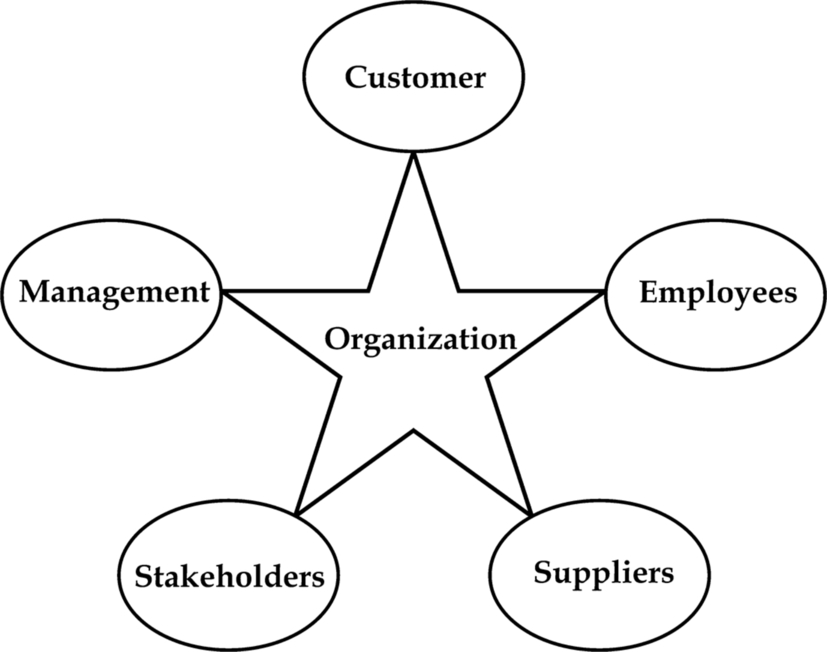
10.4 Customer’s Perception of Quality
1. Performance: The product’s primary functional characteristics. It is the functional ability and reliability to serve the customers’ purpose, also called “Fitness for use,” as defined by Juran. For example, in an automobile, the characteristics include correctly working accelerator, brake lever, properly closing doors, etc.
2. Features: The accessories and add-ons, etc. For automobiles, these may include cassette deck, power steering, burglar alarms, etc. In refrigerators, this may include built-in stabilizer, freeze control, water dispenser, etc. For electrical appliances, this may include electronic speed control, etc.
3. Aesthetics: This includes the shape, the external appearance, color, and also how the product looks, feels, smells, etc.
4. Durability: This would include the period for which the product would serve without failures, as well as with minor failures that could be adjusted by the customer himself, without having to go to service personnel. In general, this applies to the wear and tear endured by the product due to constant usage. For automobiles, this would also include the mileage between services.
5. Serviceability: It is the speed, courtesy, and competence of the after sales service. For an automobile, this also includes the kilometer service between breakdowns, the cost of service, availability of spare parts, etc.
6. Warranty: It is the quality assurance, reliability, and durability for a minimum length of time. While the term “guarantee” is used for a verbal assurance as well as the confidence created in the customer due to the reputation of the product, the term “warranty” refers to a written commitment from the supplier for free repair or replacement for a minimum period in case of failures. During the days of a seller’s market, the supplier’s liability was minimal, but today with the competition, the customer’s awareness of his right to a warranty and guarantee has increased. This has contributed significantly to the adherence to a high quality levels by the manufacturers.
7. Reputation: This is the confidence created by the company and the brand name in maintenance of quality, reliability, and aesthetics. In general, customers prefer products from companies like Tata, Godrej, TVS, and Colgate rather than experimenting with new products or brands, even if they are cheaper.
8. Price: Last, but not least, and notwithstanding the previous parameters, a more significant perception of the customer is the price of the product without any sacrifice in the quality.
10.5 Types of Customers
While the Japanese Professor Noriaki Kano classifies the customer needs as satisfiers and dissatisfiers, further explained in Section 10.9, we can broadly classify the customers into four types.
Type A Customers: Customers who know what they want, but do not express themselves or demand their wants. They are called normal customers. They can be awakened and satisfied by customer surveys, advertisements, campaigns, promotions, gift/discount offers, etc., which would have a positive effect on them. Nevertheless, satisfying them fully would be difficult. Their requirements are called satisfiers.
Type B Customers: Customers who do not know what they want, but are conscious that they do not know or express themselves. However, any knowledge about the innovations made or improvements made in the product would excite them and keep them satisfied. They are called active customers and their requirements are called exciters. They are amicable to personal and direct contacts. A little bit of talking to them about the product, explaining positive features, and how to use the product would satisfy them easily.
Type C Customers: Customers who know what they want and expect these wants to be incorporated into the product, even when they neither express, nor ask for them. They are called demanding customers. They are not satisfied easily. Even when their requirements are satisfied, they may not express any joy, considering it as a minimum the company can do for them, and they expect even more. But on the other hand, any nonprovision of their expectations would dissatisfy them and drive them away from the product and the company. Their demands are hence called dissatisfiers, as per Kano’s model. A large percentage of customers fall into this group. In order to maintain a high level of customer satisfaction, it is essential to master the art of estimating the customers’ needs by constant interaction with the customers, either directly by surveys, questionnaires, etc., or indirectly through media, etc.
Type D Customers: Customers who do not know what they want, and are neither conscious of this fact, nor care much about the characteristics of the product, as long as they are functional. They are called passive customers. Being gentle with them would easily satisfy them.
While Kano classifies the customers based on their satisfaction detailed above, Besterfield classifies information collected based on the voice of the customer as follows.
1. Solicited, Measurable, Routine: Obtained through Customer and Market Surveys, trade trials, etc.
2. Unsolicited, Measurable, Routine: Obtained through Customer Complaints, Lawsuits, etc.
3. Solicited, Subjective, Routine: Obtained through Focus Groups.
4. Solicited, Subjective, Haphazard: Obtained through Trade and Customer Visits, Independent Consultants, etc.
5. Unsolicited, Subjective, Haphazard: Obtained through conventions, Vendors, Suppliers, etc.
10.6 Internal Customers
As seen in earlier chapters, the concept of total quality management (TQM) is essential for all levels and functions across the organization, and it would be necessary to draw all people into the TQM process. This can be achieved through the concept of internal customer within the company. Here, each and every department is treated as an internal customer for the preceding department from which material or services flow. The internal customer-supplier link among individuals, departments, and functions build up the chain of customers throughout an organization that connects every individual and function to the external customers and consumers, thus characterizing the organization’s value chain and overall awareness of the quality maintenance through customer satisfaction.
For example, in a bicycle factory, where the general flow of in-process goods are in the machine shop, this can be treated as the internal customer to the press shop so that the former department would ensure quality, service, delivery dates, etc., as much as the company cares for its external customer. This will enable each person in each department to get the motivation that he is a very important cogwheel of the TQM process. As a result of this motivation and the process focus, several companies could continuously improve the quality and simultaneously bring down the cost of quality, which had earlier been the prime cause for the poor performance of the company.
Similarly, the plant engineering department would consider those departments that consume steam or compressed air as their customers. The head of the Human Resources department would consider each trainee as the internal customer for their training programs. Fig. 10.2 illustrates this concept of internal and external customers.

Similarly, an educational institution can be said to have their internal and external customers as illustrated in Fig. 10.3.
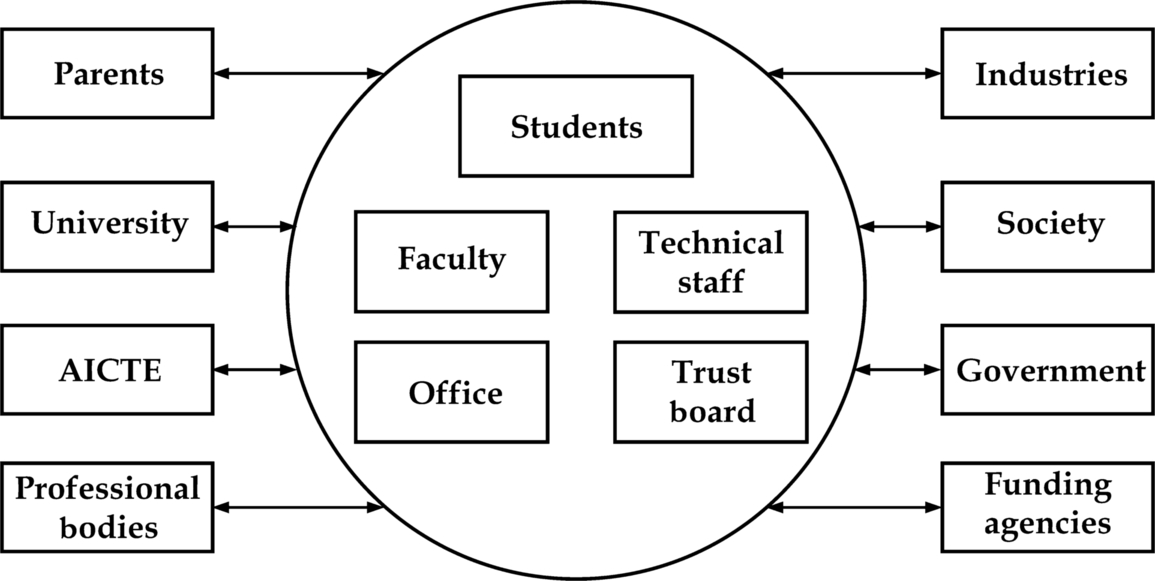
10.7 Customer Satisfaction
During the days of a sellers’ market, whatever goods were manufactured were sold because the demand is higher than the supply. The customer had to be content with what he received.
But today in the wake of the buyers’ market, as illustrated in Section 10.1, the customer is not satisfied unless he gets what he wants. If not, he has many competitors’ products from which to choose. Hence, an organization’s success depends largely on the customer and how he expresses his satisfaction about the products and services. In other words, customer satisfaction is the goal of an organization. A majority of the repurchases come from customers who are satisfied with the company’s products. Customer satisfaction plays an important role in customer retention. There is also an old saying that if a customer likes a company’s service, he will tell three people about it and if he does not like it, he will tell eleven people. On the other hand, as another saying goes, the satisfied customers tell their satisfaction or their good experience to twice as many friends than they tell about their bad experience. One study found that companies with 98% customer satisfaction and retention are twice as profitable as those with 90%.
10.8 Customer Delight
When the organization’s products and services exceed the customer’s expectations, he is delighted, like getting an unexpected new feature in the product, or the CEO inviting him for a cup of coffee, when he goes to shop. To achieve this, the company should understand what the customer expects and establish effective channels of communication and feedback with the customer.
10.9 Kano Model of Customer Satisfaction
Noriaki Kano puts forward three major classifications of the customer requirements as:
● Unspoken, but anticipated by all (basic),
● Spoken (specified or required),
● Unspoken and unanticipated, but delighted if incorporated.
Most hidden facts about the quality features the customer expects are usually unspoken or unclear, but are presumed to be basic. However, the customer expectations that are spoken have only a small impact compared to those unspoken, but are anticipated as basic requirements of a product.
With these points in mind, Kano developed a model as shown in Fig. 10.4, indicating the possible impact on customer satisfaction by fulfilling or not fulfilling the above requirements. The three curves shown (Fig. 10.4) as A, B, and C can further be explained needs are not fully satisfied.

Curve A: Customer requirements that are easily identified both by the manufacturer and the customer himself. Hence, the more these requirements are satisfied, the more the customer is satisfied.
Curve B: Innovations by the manufacturer that are well publicized. The customer gets excited about these and is happy, even if his needs are not fully satisfied.
Curve C: The requirements that are not indicated specifically by the customer, but which he expects to be automatically satisfied. This requires a careful analysis by the manufacturer. Sometimes despite much effort made to incorporate the estimated requirements, the customer still wants something more. This dissatisfaction may not be indicated in written terms, but he may get attracted by the competitor’s products, which he thinks would satisfy these requirements.
When there are two customer needs of which only one can be satisfied at the same time, due to technical or financial needs, Kano’s model helps to identify which of these two needs is more significant and should be satisfied.
In 1996, Sauerwein proposed a questionnaire to analyze the problems that can be anticipated by not fulfilling them as below:
1. Which functions does the customer expect while using the product?
2. Which problems/defects/complaints does the customer associate with the use of the product?
3. Which criteria does the customer take into consideration when buying the product?
4. Which new features or services would better meet the expectations of the customer?
10.10 American Customer Satisfaction Index
The American Customer Satisfaction Index (ACSI) is an economic indicator (Fig. 10.5) that links customer satisfaction to its determinants, such as customer satisfaction, perceived quality, and the value addition to the customer. This index uses tested economic models to produce four levels of indexes drawn on the basis of a survey conducted in a national sample of 46,000 consumers who recently bought, or used products from 40 specific industries from seven industrial groups, and 203 other companies and agencies within that group. ACSI was developed by the American Society of Quality (ASQ) with the help of Michigan Business School, with a primary goal to create public awareness and perception of quality.
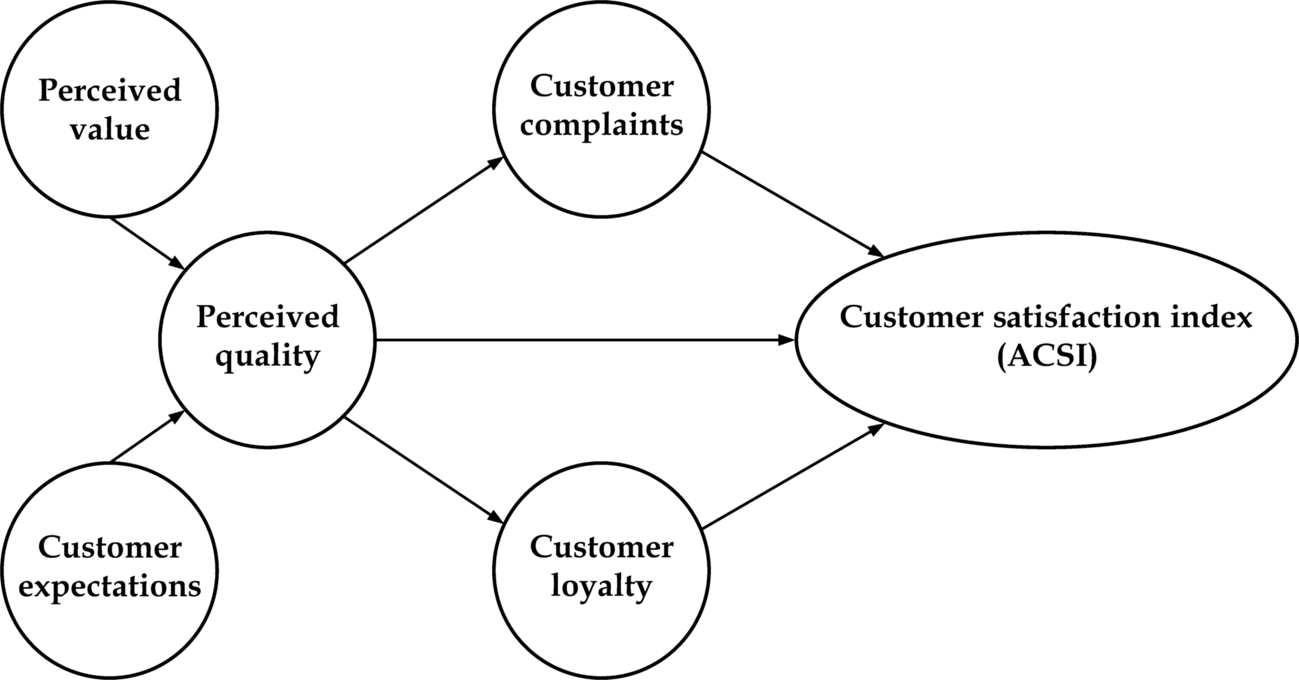
10.11 Customer Retention
Besides providing products and services that achieve customer satisfaction and delight, it is also essential to achieve customer retention. It is the process of creating customer loyalty, so that he continues to prefer to use these products and services, despite minor variations in the market conditions, such as the competitor offering the same at a marginally lower price. The customer should be made to feel proud of using these products and services. The product quality and the customer relationships maintained by the front line employees play a vital role in this customer retention. If 70% of the customers are retained and efforts are made to improve this to 90%, it would be easier than creating a new customer level of 10%, the customer growth of 10% would reflect on the total business growth.
10.11.1 Tips for Customer Retention
● Market to your Own Customers: As explained earlier, once the existing customers are satisfied with the product, they would more easily buy more products, in addition to recommending them to their friends.
● Use Complaints to Build Business: Maintain follow-up with the customers and if they have any complaints or suggestions, express your seriousness in examining them. If a prompt follow-up action is made to resolve a complaint, the customer is more likely to do more business than an average customer.
● Reach Out to Your Customer: The more the customer sees your staff, the more likely he is to make the next purchase.
● Loyal Workforce: Make all out efforts in retaining the front-line staff, like technical support and customer service staff, who form a vital link between the company and the customers. This is further illustrated in Section 10.18.
10.11.2 Profitability Associated With Customer Retention
According to Buchanan and Gilles (1990), the increased profitability associated with customer retention efforts occurs because:
● The cost of acquisition occurs only at the beginning of a relationship. The longer the relationship is, the lower is the amortized cost.
● Account maintenance costs decline as a percentage of total costs (or as a percentage of revenue).
● Long-term customers tend to be less inclined to switch, and also tend to be less price sensitive. This can result in stable unit sales volume and increases in rupee sales volume.
● Long-term customers may initiate free word of mouth promotions and referrals.
● Long-term customers are more likely to purchase ancillary products and high-margin supplemental products.
● Long-term customers tend to be satisfied with their relationship with the company and are less likely to switch to competitors, making market entry or competitors’ market share gains difficult.
● Regular customers tend to be less expensive to service because they are familiar with the processes involved, require less “education,” and are consistent in their order placement.
Increased customer retention and loyalty makes the employees’ jobs easier and more satisfying. In turn, happy employees feed back into higher customer satisfaction in a virtuous circle.
10.12 Customer Loyalty
Customer loyalty is customers adhering to a single company or its products. They become satisfied with those products, either by way of the quality of the product, or the esteem they feel by possessing the product. They not only feel loyal to the product, but also tend to purchase other products from the same company depending on their need, rather than purchasing from the competitor. They make positive referrals. For example, if a customer is satisfied with Godrej steel furniture that has served him for decades, he prefers to purchase Godrej refrigerator in preference to other makes, when he next needs a refrigerator. Even for purchasing soaps and shaving cream, he may prefer to buy those of Godrej make only.
This author would like to distinguish between customer satisfaction and customer loyalty by saying “satisfaction is a behavior, while loyalty is an attitude.” (This is different from what Evans & Lindsay say, “satisfaction is an attitude and loyalty is a behavior.”) The satisfied customers may often purchase competitors’ products due to convenience, or promotion, or the discounts, etc., offered. But loyal customers place priority on purchasing goods from a particular company, even at a higher price than the competitors’.
For example, Kodak is considered as the best for rolls of film for 35 mm cameras and generally receives higher ratings. However, its market share is less than that of Konica. This lack of correlation suggests that the satisfaction of Kodak customers does not necessarily influence their survey opinions. On the other hand, loyal customers stick to Kodak films.
In 1987, Le Boeuf cited the results of a study to establish that companies spend six times more to get new customers than to retain old customers. Similarly, customer loyalty is worth ten times that of marketing of a single product or service. The virtuous circle of customer loyalty can be illustrated by Fig. 10.6.

10.13 Factors for Establishing Loyal Customers
The factors that influence the ability to build a strong loyal customer base can be stated as:
1. Products that are highly differentiated from those of the competitors.
2. Higher-end products, where the price is not the primary purchasing factor.
3. Products with a high service component.
4. Multiple products for the same customer.
5. Last but not the least, is the fact that “you cannot create loyal customers without first creating satisfied customers.”
10.14 Customer Attrition
Wikipedia introduced another term—Customer attrition, an antonym for customer retention. It can also be described as customer churn, customer turnover, or customer defection, terms used to describe loss of customers.
Banks and mobile phone service companies often use customer attrition analysis and customer attrition rate as one of their key business indices. The customer churn can either be voluntary or involuntary, the former occurring due to a decision by the customer to switch to products of a competitor company, and the latter occuring due to circumstances, such as the customer’s death, or relocation to a distant city, etc.
10.15 How Companies Lose Their Customers
In 1987, Le Boeuf cited the following results of a study on why customers quit the relationship with a particular supplier.
10.16 Customer Surveys
The customer survey is a process of discovering whether or not a company’s customers are happy or satisfied with the products or services received from the company. It may be conducted face-to-face, over the phone, via email or internet, or on handwritten forms. Customers’ answers to questions aid the company to analyze whether or not changes need to be made in business operations to increase overall customer satisfaction.
Business directory defines customer survey as, “Customer polling to identify their level of satisfaction with an existing product, and to discover their express and hidden needs and expectations for new or proposed product(s).”
The Qualifications and Credit Framework (QCF) suggests the following guidelines for conducting customer surveys.
1. Data collected through survey should not only be rich, but also informative to take appropriate action.
2. Distinguish between clients and customers.
3. Through surveys customer expectations are realized.
4. The answers from a questionnaire will be directly in tune with the way a question is asked. If we want a better answer, the questions asked should be specific.
5. The time for getting responses to a questionnaire is very short, maybe only 10 to 12 minutes.
6. A thoughtfully, well-planned questionnaire will help in easy data analysis and its interpretation. How you ask and what you ask are as important as whom you ask the questions.
7. Before collecting the data, plan first how the data is proposed to be analyzed and used, and also decide on the nature of clients who will be surveyed.
10.17 Customer and Quality Service
What all we discussed in the previous section holds true for the quality of service provided to the customer by the organization. In fact, service quality has a direct and immediate impact on customer satisfaction and hence, is discussed more in detail below.
Service can be defined as any primary or complementary activity that does not directly produce a physical product. It is the nongoods part of the transaction between the customer and the service provider. The service can be as complex as a repair of a car, or as simple as handling a complaint.
When the customer is happy with service and the product, and interacts with enthusiastic, knowledgeable, and committed service personnel who are anxious to help, the company would continue to enjoy the patronage of these customers for a long time, as illustrated in Section 10.12. As per an old saying that if a customer likes the service, he will tell three people. If he does not like it, he will tell eleven people.
10.18 The Key Elements of Service Quality
1. Reliability: It is the ability to provide what was promised, as inmaking the repair correctly the first time, following the customers’ instructions.
2. Assurance: It includes not only the courtesy extended by the employee, but also the knowledge possessed by him, so as to convey trust and confidence among the customers.
3. Empathy and responsiveness: The willingness to help customers and the degree of individual attention given to provide prompt service is the basic element of the survive quality. This will make the customer feel valued.
4. Communication: The number of contact points shall be minimized and the documents shall be in customer-friendly language.
5. Front line people: Frontline people are those service personnel who keep in direct contact with the customers. They should be very customer-friendly, treat the customers with courtesy, and have considerable patience to listen to them.
6. Organization: The customer reception area shall be clean and comfortable. The full details of the services provided by the office shall be displayed in the office. It is also a good idea to display customer-oriented slogans in the reception area to attract and give a positive impression to the customers.
7. Tangibles: Tangibles are the physical facilities, equipment for service, and also the appropriate appearance of the front line people, etc., which would be witnessed by customers who come to the service shop. Availability of good tangibles with the company will instill confidence in the customers.
10.19 Customer Retention Versus Employee Morale
See Fig. 10.7.
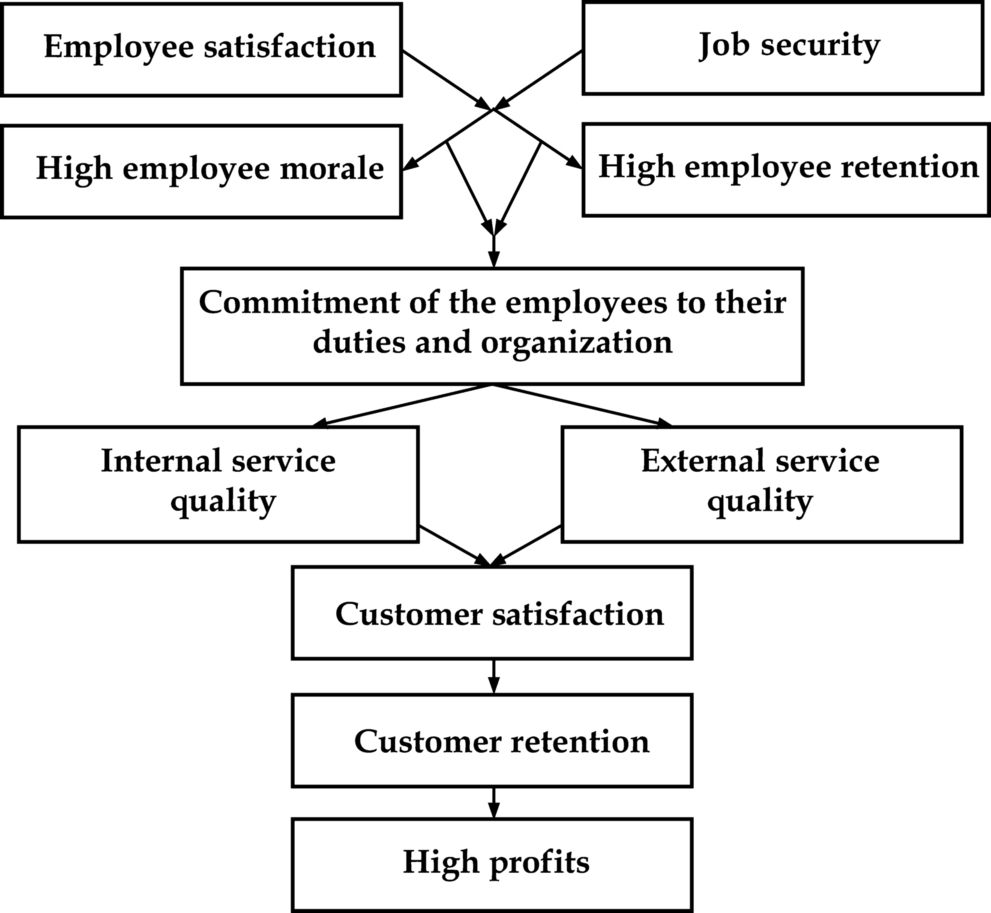
10.20 Action to be Taken to Handle Customer Complaints
1. Investigate customer complaints by proactively soliciting feedback, both positive and negative.
2. Develop procedures for complaint resolution that include empowering the front-line personnel.
3. Analyze the complaints, fitting them into clear and definable categories.
4. Work to identify the process and material variations and eliminate the root cause.
5. Remember that subjecting the defects to more inspection is not the right solution.
6. When the survey response or the feedback is received, the senior manager should contact the customer and strive to resolve the issue.
7. Establish customer satisfaction measures and constantly monitor them.
8. Communicate complaint information and the results of the investigation to all related persons in the organization.
9. Provide a monthly complaints log report to the quality council or the process improvement teams for their evaluation.
10. As far as possible, strive to identify the customers’ expectations beforehand, rather than as a postmortem.
10.21 Healthy Practices by Customer Focused Organizations
Evans and Lindsay emphasize the following healthy practices adopted by customer-focused organizations.
1. They clearly define the key customer groups and markets, considering competitors and other potential customers, and then segment their customers accordingly.
2. They understand both near-term and long-term customer needs and expectations, and employ systematic procedures for listening and learning from the customer. This is called the voice of the customer by Dr. Mizuno, who developed quality function deployment, an effective technique to incorporate customer requirements in the design process. More of this is discussed in later chapters.
3. They understand the linkage between the voice of the customer and design, production, and delivery process.
4. They build relationships with customers through commitments that promote trust and confidence, provide easy accessibility to people, and informs them, set effective service standards, train customer contact employees, and effectively follow up on products, services, and transactions.
5. They have effective complaint management systems by which customers can easily comment, complain, and receive prompt resolution of their concerns.
6. They measure customer satisfaction, compare the results in relation to competitors and use the information to evaluate and improve upon the internal processes.
10.22 Customer Code of Ethics to be Followed
1. Keep your promises made to the customer.
2. Return calls to the customer in a prompt manner.
3. Patiently listen to the customers about their concerns, referring to the appropriate staff member for problem-solving.
4. Treat the customers with respect, courtesy, and professionalism at all times.
5. Give them personal attention.
6. Be aware and evaluate the customer satisfaction regularly.
7. Continuously search for customer-related improvements.
8. Deliver services and products quickly and effectively.
9. Maintain a clean and neat environment and personal appearance.
10. Review and implement customer feedback and suggestions into current procedures when possible.
11. Engage in any training or education that will enhance the job performance and the commitment to the customer.
12. Finally, treat every customer just as you would like to be treated by others.
10.23 Recently Held International Quality Symposia
In October 2013, the second IAQ/ANQ Symposium was held in Bangkok. In his keynote address at this symposium, Prof. Noriaki Kano emphasized that the basic step in increasing the customer satisfaction is to eliminate customer problems. He summarized that sales depended on demand and marketing share. While demand is affected by change of market structure and also the appropriateness of the demand prediction, market share is affected by what are called “business approach ratio” and “successful ratio,” which again depended upon the quality, price, delivery, and sales activities.
On Nov. 18, 2014, the second World Quality Day Celebrations were held at Zayed University in Dubai, the theme being “Culture of quality—accelerating growth and performance in the emerging world economy.” The keynote address emphasized that “In the future, there will be no such people as quality professional as we know today. Everyone in every function is responsible for the quality of output.”
10.24 Conclusion
As we have seen in this chapter, in a competitive marketplace, customer satisfaction plays a key role in business strategy. It is therefore essential for companies to effectively manage customer satisfaction by taking reliable and representative measures for this satisfaction.
